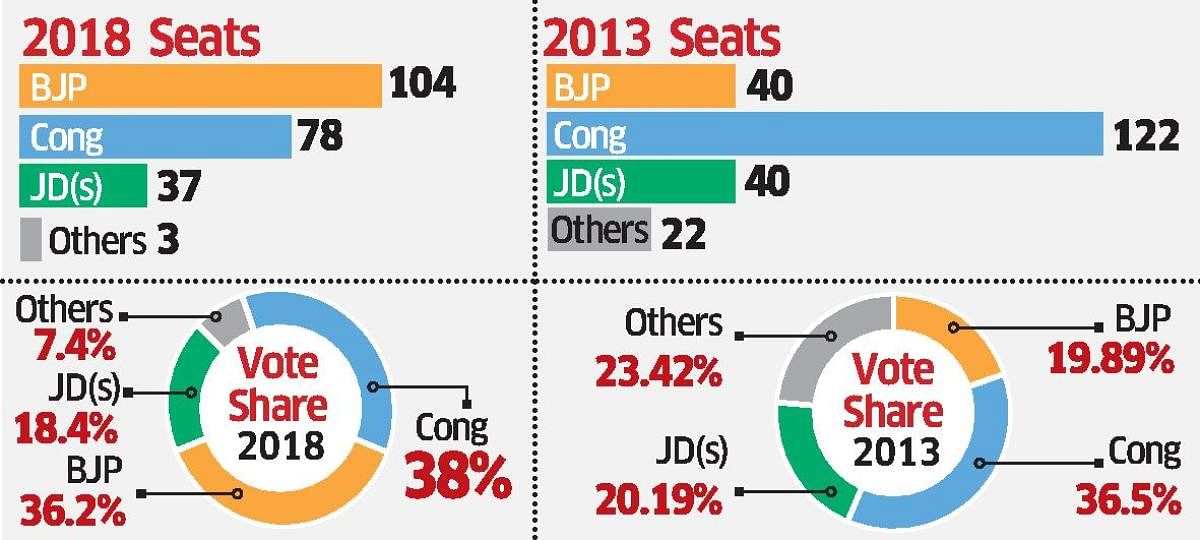Even a T-20 match could not have been more exciting. But the stakes in elections are far higher than in a cricket match. Right up to the end, the BJP was moving towards a decisive win and there were celebrations about it forming a government on its own. At the last moment, the results swung the other way and the BJP was denied a clear majority. Before we speculate on the government formation, we need to look at some important aspects of the results and the campaigns.
First, the BJP was the clear leader, winning 104 seats. The Congress was a poor second at 78, and the JD(S) a distant third with 37 seats with 2 seats going to others. There are two more seats yet to be contested where elections were postponed. But even with that, the BJP would not come up to a clear majority.
Next, we need to look at the vote shares. Surprisingly, the Congress got 38%, a clear lead over the BJP’s 36.2%. The JD(S) got 18.4%. In the 2013 Assembly elections, the Congress got 36.59%, so it actually improved its performance this time. The BJP of course went up from 19.89% to 36.2%, handsomely increasing its vote share. The JD(S) got 20.19% in 2013, more than the BJP, but this time its vote share has dipped.
This means that both the BJP and the Congress have done better in terms of vote share than 2013. Of course, the BJP has done far better than 2013 in both seats and vote share. It has clearly taken away the votes from other parties as well as Independents this time. But not from the other two parties.
An interesting and perhaps slightly disturbing trend we see in several elections, is where a party with a higher percentage of votes gets less seats than another party with lower votes. In the recent Uttar Pradesh Assembly elections, the BJP got twice the votes of the BSP, but got more than 20 times the number of seats. The same fate was suffered by BJP in the 2013 Karnataka polls where with less than twice the number of votes, the Congress got more than three times the seats compared to the BJP.
That is why many are advocating for a change in the electoral system. We either move towards the US system where the chief minister is directly elected, or a French system where there is a run-off election if no candidate in a constituency gets 50% of the votes, or the German-European system where there is proportional representation based on vote share.
An Indian variation could be a multi-MLA constituency where anyone with 35% or more is declared elected. So we can have at most two MLAs per constituency. After all, in closely contested seats (last time, one seat was decided by 350 votes), those who vote for the loser go unrepresented. The winner takes all is a Western concept, whereas in India we are more tolerant of each other. Also the huge spending, the shrill criticism of the opposition and divisive politics will come down when serious candidates realise they have to get about 35% of the votes.
There are endless permutations and combinations that are being debated. Caste, religion and region wise votes (Coastal, Mysore, Bombay and Hyderabad Karnataka), rural versus urban votes, young voters, women voters and so on. Add to that the campaign strategies used by various parties, the Congress attempt to split the Lingayat vote by recommending minority status for them, and the return of Yeddyurappa and the Reddy brothers from Ballari to the BJP. Other factors are voters preferring the same government in the state as the Centre, and the Karnataka tradition of always voting out the incumbent government.
Of the various factors, the BJP campaign has probably yielded very good results for them. The micro management of the campaign constituency wise, the return of Yeddyurappa, the use of the prime minister in the campaign, and of course, the huge amount of money spent played a decisive role. A surprising factor was the large gain by the BJP among rural voters and the relative decline of the Congress.
Dealing low blows
What was the campaign like? It was business as usual, with huge electoral spending, use of national leaders, big rallies, promises of various schemes, promises of subsidies and loan waivers, and the massive use of the digital and social media. We even saw 10,000 genuine voter ID cards locked up in an apartment. What other back room deals were struck is anyone’s guess. Campaign speeches hit below the belt, and the language did sink a little lower compared to 2013. The aim seems to be to win elections by any means.
The campaigns also missed people’s real concerns. Three major Karnataka-wide surveys clearly show that voters want employment or jobs, water, education, health, better roads and electricity, and urban facilities like garbage clearance. But there was hardly any mention of the top two items — jobs and water — in the campaigns. These are managed campaigns that do not fully reflect people’s concerns. Each voter needs to ask himself — did my favourite party do the right thing?
Who will form a government? Will that government be stable? For now, the Congress-JD(S) alliance as well as the BJP have staked a claim on the throne. The governor is set to decide soon. Whatever decision he takes will be both praised and criticised. The matter may even end up in court.
Did democracy win? We surely need campaigns with less bitterness and money power. Did the people of Karnataka win? If we get good governance from whoever forms the government, then the people have won. Otherwise some political party has won. Time will tell.
--
(The writer is professor at IIM Bangalore and Chairman-Founder, ADR)
